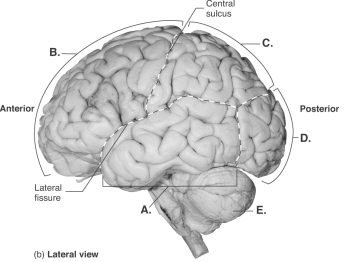A) Flex his fingers.
B) Talk to the surgeon.
C) Smile.
D) Feel pressure on his toes.
E) Move his hand.
G) A) and D)
Correct Answer

verified
Correct Answer
verified
Multiple Choice
Most sensory input that ascends through the spinal cord and brainstem projects to the
A) pineal gland.
B) hypothalamus.
C) thalamus.
D) mammillary bodies.
E) subthalamus.
G) A) and C)
Correct Answer

verified
Correct Answer
verified
Multiple Choice
Which of the following is a function of the hypothalamus?
A) initiates voluntary movements
B) involved in psychosomatic illnesses
C) control of balance
D) unconscious swinging of the arms while walking
E) perception of sensation
G) B) and C)
Correct Answer

verified
Correct Answer
verified
Multiple Choice
Which of the following cranial nerves does not innervate the tongue?
A) glossopharyngeal
B) hypoglossal
C) accessory
D) facial
E) All of these would innervate the tongue
G) A) and E)
Correct Answer

verified
Correct Answer
verified
Multiple Choice
Damage to pontine nuclei might affect
A) vision.
B) talking.
C) blood pressure.
D) respiration.
E) heart rate.
G) D) and E)
Correct Answer

verified
Correct Answer
verified
Multiple Choice
Projection fibers will connect
A) the cerebrum to other parts of the brain and the spinal cord.
B) one cerebral hemisphere to the other hemisphere.
C) parts of the same hemisphere.
D) motor and sensory areas of the cerebral cortex.
F) A) and D)
Correct Answer

verified
Correct Answer
verified
Multiple Choice
Walking a tightrope would activate what portion(s) of the medulla?
A) the pyramids
B) the superior colliculi
C) the olives
D) the pyramids and the superior colliculi
E) the pyramids and the olives
G) A) and C)
Correct Answer

verified
Correct Answer
verified
Short Answer
Cerebrospinal fluid flows through the where it enters the venous circulation.
Correct Answer

verified
Subarachno...View Answer
Show Answer
Correct Answer
verified
View Answer
Multiple Choice
Consider the following five terms and determine which does not belong.
A) medulla oblongata
B) pons
C) cardiac center
D) pyramids
E) olives
G) B) and E)
Correct Answer

verified
Correct Answer
verified
Multiple Choice
Which of the following feelings is NOT related to hypothalamic function?
A) fear of the unknown
B) sexual pleasure
C) feeling satiated after a meal
D) feeling rested after flying to England
E) road rage
G) B) and E)
Correct Answer

verified
Correct Answer
verified
Multiple Choice
What is the group of structures in the brain that is involved with emotions and memory?
A) reticular formation
B) limbic system
C) basal nuclei
E) A) and C)
Correct Answer

verified
Correct Answer
verified
Multiple Choice
What type of white fibers connect areas of the cerebral cortex in the same hemisphere?
A) basal fibers
B) commissural fibers
C) projection fibers
D) association fibers
F) A) and B)
Correct Answer

verified
Correct Answer
verified
Multiple Choice
The abducens nerves
A) transmit pain impulses from the teeth.
B) are involved in eye movement.
C) dilate blood vessels in the skin.
D) slow the heart rate.
E) control size of the pupil.
G) None of the above
Correct Answer

verified
Correct Answer
verified
Multiple Choice
 -This is a lateral view of the brain. What does "A" represent?
-This is a lateral view of the brain. What does "A" represent?
A) temporal lobe
B) cerebellum
C) frontal lobe
D) occipital lobe
E) parietal lobe
G) A) and C)
Correct Answer

verified
Correct Answer
verified
Multiple Choice
Unilateral damage to a cranial nerve is suspected because the tongue deviates to the right when it is protruded. Which cranial nerve is damaged?
A) right hypoglossal
B) left hypoglossal
C) right glossopharyngeal
D) left glossopharyngeal
E) left facial
G) A) and B)
Correct Answer

verified
Correct Answer
verified
Multiple Choice
The cerebellum communicates with other parts of the CNS by means of nerve tracts called the
A) vermis.
B) flocculonodular pathways.
C) cerebellar peduncles.
D) arbor vitae.
E) folia.
G) B) and E)
Correct Answer

verified
Correct Answer
verified
Multiple Choice
The oculomotor nerve
A) innervates all the muscles that move the eyeball.
B) adjusts pupil size to the level of lighting.
C) transmits action potentials from the retina.
D) controls the organ of balance.
E) innervates two of the six muscles that move the eyeball.
G) A) and C)
Correct Answer

verified
Correct Answer
verified
Multiple Choice
Which of the following is correctly associated with the medulla oblongata?
A) It gives rise to conscious thoughts.
B) It contains nuclei for regulation of heart rate and blood vessel diameter.
C) It contains enlargements called cerebral peduncles.
D) It is the most superior portion of the brainstem.
E) It relays sensory information.
G) A) and C)
Correct Answer

verified
Correct Answer
verified
Multiple Choice
Which ventricle is located between the two halves of the thalamus?
A) first ventricle
B) second ventricle
C) third ventricle
D) fourth ventricle
F) A) and C)
Correct Answer

verified
Correct Answer
verified
Multiple Choice
Which of the following terms does NOT belong with the others?
A) medulla oblongata
B) midbrain
C) pons
D) thalamus
E) reticular formation
G) C) and D)
Correct Answer

verified
Correct Answer
verified
Showing 41 - 60 of 158
Related Exams